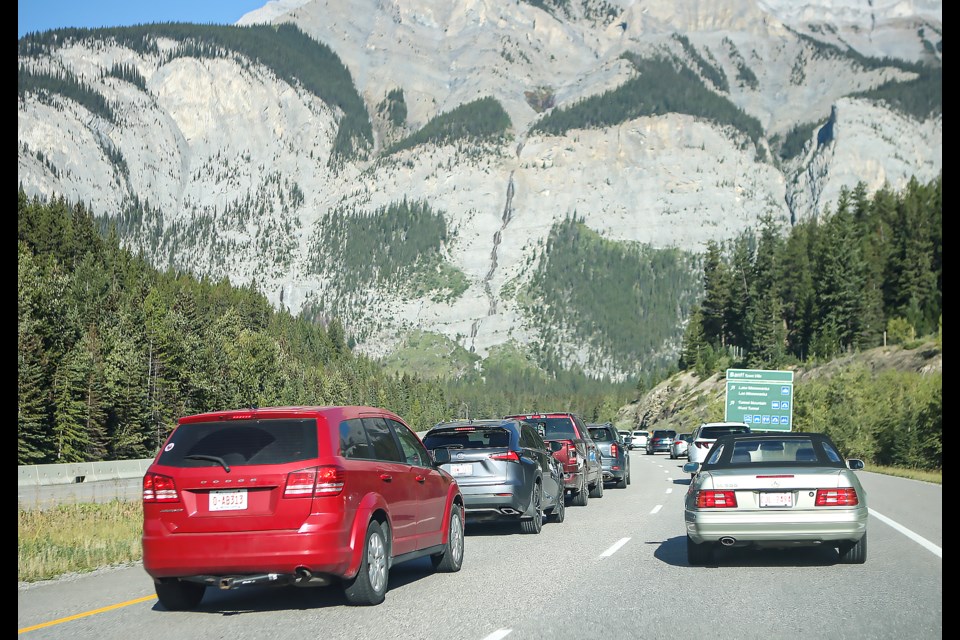BANFF NATIONAL PARK – The village of Lake Louise was temporarily shut down as hordes of tourists flocked to the mountains over the busy Labour Day long weekend.
For about two hours on Saturday afternoon (Sept. 2), Parks Canada allowed only residents and guests with hotel reservations to enter Lake Louise.
Officials with Parks Canada say this is part of a pre-planned procedure that gets triggered when traffic congestion reaches threshold that risks hindering emergency vehicle access to Lake Louise and creating back ups on the Trans-Canada Highway.
Ashley Gales, a spokesperson for Lake Louise, Yoho and Kootenay field unit, said similar to the August long weekend, a short phase 2 traffic diversion was initiated from 4 p.m. to 6:15 p.m. on Saturday (Sept. 2).
“A phase 2 is where access past the Lake Louise Village is blocked and non-residents or people without accommodation reservations are diverted back onto the highway,” she said.
The Banff townsite was extremely busy, but there were no reports of Parks Canada shutting down the Lake Minnewanka Loop as was done on July 22. It was the first time this year traffic was turned away from the scenic loop road.
In the Banff townsite, three of the four long weekend days from Friday through Monday were above Banff’s threshold of 24,000 vehicles per day that causes congestion. Monday was the only day that wasn’t.
“We expect the smoke and air quality statement for Monday had the biggest impact,” said Jason Darrah, the director of communications and marketing for the Town of Banff.
According to the Town of Banff, total vehicle volumes for the two main entrances for the weekend were 108,349, a one per cent decrease from 2022 and unchanged from the pre-COVID-19 pandemic year of 2019.
Vehicle volumes above the Banff Avenue Bridge across the Bow River were down two per cent to 53,258 from 2022, and down 18 per cent from 2019.
However, the number of vehicles on Mountain Avenue heading to and from popular tourist hot spots like the hot springs and gondola on Sulphur Mountain were up four per cent from last year to 18,740, but down 18 per cent from 2019.
“Heavy congestion occurred throughout town on Saturday afternoon due to extremely high incoming hourly vehicle volumes at the east entrance,” said Darrah, noting an average of 900 vehicles per hour for four consecutive hours from 11a.m. to 3 p.m.
“This was probably due in part to traffic back-ups on Highway 1, which was reduced to one lane in each direction between the east and west entrances until mid-afternoon, as a result of a detour around a sinkhole in the eastbound lanes.”
Darrah said Roam transit local ridership for the long weekend increased 39 per cent from 2022 and 67 per cent from 2019, while regional ridership between Banff and Canmore increased 37 per cent from 2022 and 54 per cent from 2019.
Also on a positive note, he said main entrance volumes were unchanged from 2019 volumes versus significant decreases of 18 per cent over the Banff Avenue Bridge and on Mountain Avenue.
“(This) combined with a 67 per cent increase in local transit ridership illustrate a welcome mode shift away from private vehicle use and toward sustainable transportation to south side destinations in Banff,” he said.
Darrah said factors contributing to this include free transit for locals and Banff Gondola passengers as well as increased frequency on Roam Routes 1 and 2.
He said there is also strong promotion and uptake of local and regional transit use and active mode travel, as well as timely messaging when the Sulphur Mountain parking lot is full. Many people also walk across the new pedestrian bridge instead of driving.




